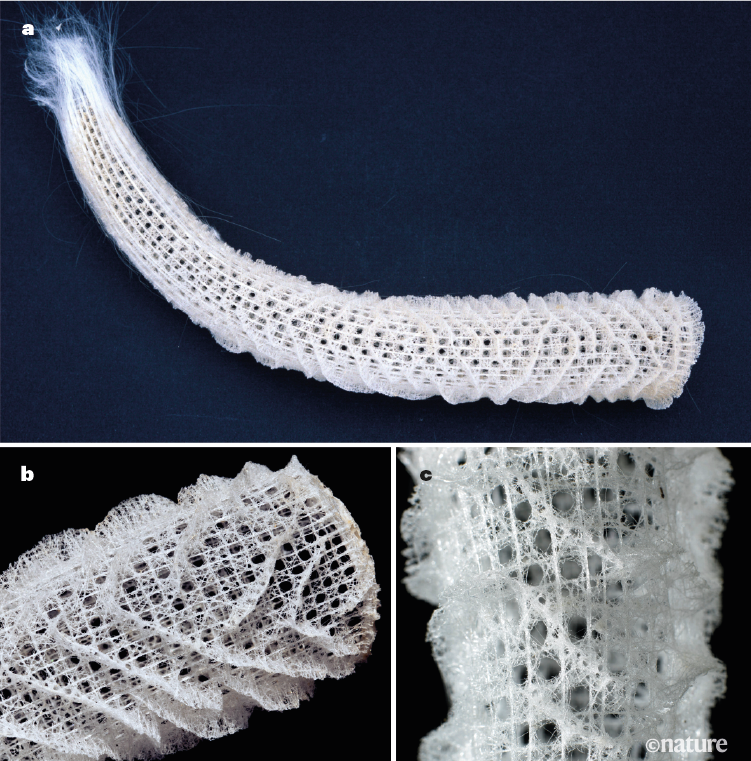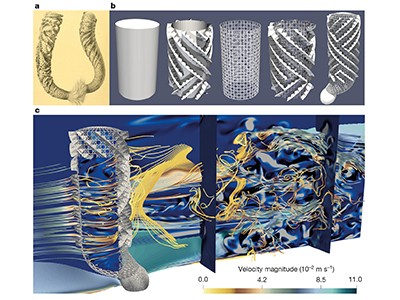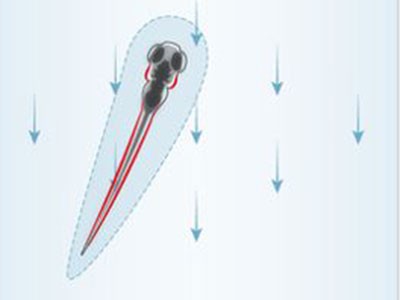The deep-sea sponge Euplectella aspergillum, also known as Venus’s flower basket, is celebrated for its intricate glass skeleton. This structure provides remarkable mechanical support and has inspired a generation of strong, lightweight bridges and skyscrapers1. Water is continuously drawn into and out of the sponge’s central body cavity through pores, to filter food particles and exchange gases. Although the mechanical properties of the sponge’s skeleton are well documented, little is known about the detailed fluid flows around and through the organism. In a paper in Nature, Falcucci et al.2 use state-of-the-art fluid-dynamics simulations to resolve these flows. Their results show that the sponge’s structural elements reduce the impact of hydrodynamic forces on the organism and generate internal circulation patterns that might be used for feeding and sexual reproduction.
The skeleton of E. aspergillum consists of a regular square lattice that is diagonally reinforced and forms scaffolding for the sponge’s hollow cylindrical body3 (Fig. 1). In addition, external ridges spiral around the main body and are superimposed on the lattice. To deconstruct the effect of each skeletal component on the fluid flows, Falcucci and colleagues generated several idealized models of the sponge for comparison. These models included a plain solid cylinder, a solid cylinder with helical ridges, a hollow cylindrical lattice and a hollow cylindrical lattice with helical ridges.
Determining the fluid flows for these different models required extremely accurate fluid-dynamics simulations. These can simultaneously resolve a level of detail from the microscopic flows around the skeleton all the way up to the bulk flows around the entire organism. To make these in silico experiments feasible, Falcucci et al. numerically solved the equations that govern such flows using a method that lends itself particularly well to parallel computing on electronic circuits called graphics processing units4. Moreover, the authors ran the simulations on Marconi100, one of the most powerful supercomputers in the world (see go.nature.com/3hzrzjp).
It is well documented that, in water flows of 1–10 centimetres per second or more, solid cylinders roughly the size of E. aspergillum undergo vortex shedding5 — a process in which repeating patterns of swirling vortices form on the downstream side of an object. This phenomenon results in large velocity fluctuations in the wake of the cylinder, as well as varying and increased hydrodynamic drag. Falcucci and colleagues’ in silico experiments showed that a hollow cylindrical lattice acts as a porous object that suppresses such velocity fluctuations and decreases drag. Given that hydrodynamic forces can be powerful enough to dislodge a sea sponge, reduced drag improves the organism’s robustness in the presence of strong flows.
The authors also found that the inclusion of helical ridges generates low-speed vortical structures in the cylinder’s central cavity. For E. aspergillum, such flow structures probably improve the capture of food particles by increasing the rate of encounters between plankton and the sponge’s body cavity. Similarly, these structures could increase the contact between free-swimming sperm and retained eggs, thereby boosting reproductive efficiency.
Although these in silico experiments have greatly advanced what is known about fluid flow through E. aspergillum, there is still much that is not understood. For instance, Falcucci et al. were able to show that the sponge’s external helical ridges increase the residence time of particles in the central cavity. However, the extent to which this aids food uptake and gas exchange has not been quantified. Future work should consider how the low-speed vortical structures in the cavity might selectively filter particles of specific shapes and sizes.
Furthermore, it is not yet understood how cells that actively drive fluid flow through the sponge by beating their hair-like extensions (flagella) interact with the environmentally driven flows. The in silico experiments also assumed that the oncoming flow is steady and that the sponge is rigid. Deformations of the sponge in unsteady currents probably produce hydrodynamic forces that are different from the simplified case considered by the authors.
This work provides a striking example of how state-of-the-art numerical simulations can be used to explore problems in areas such as biomechanics, fundamental fluid dynamics and bioinspired design. Falcucci and colleagues’ results suggest that many of the complex structures seen in marine invertebrates and other organisms have non-intuitive consequences for fluid dynamics. The authors’ approach could be applied to a vast array of puzzles in nature related not only to food filtering, gas exchange and drag reduction, but also to pollen capture and heat loss. For example, such multiscale flow simulations could be used to understand the hydrodynamics of gas exchange through coral reefs6, or the aerodynamics of pollen capture7.
Moreover, this study of Venus’s flower basket reveals how complex geometries can manipulate fluid flow for multiple functions, including drag reduction, mechanical support and particle filtering. The lessons learnt from this organism could inspire improved multifunctional engineering structures, such as sampling and filtering devices.
"flow" - Google News
July 21, 2021 at 10:05PM
https://ift.tt/3eEGBle
Fluid flow through a deep-sea sponge could inspire engineering designs - Nature.com
"flow" - Google News
https://ift.tt/2Sw6Z5O
https://ift.tt/2zNW3tO
Bagikan Berita Ini

















0 Response to "Fluid flow through a deep-sea sponge could inspire engineering designs - Nature.com"
Post a Comment